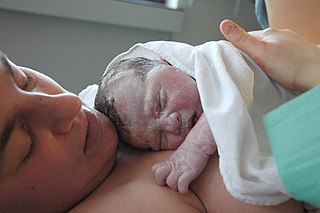 W
WChildbirth, also known as labour or delivery, is the ending of pregnancy where one or more babies leaves the uterus by passing through the vagina or by Caesarean section. In 2015, there were about 135 million births globally. About 15 million were born before 37 weeks of gestation, while between 3 and 12% were born after 42 weeks. In the developed world most deliveries occur in hospitals, while in the developing world most births take place at home with the support of a traditional birth attendant.
 W
WEmergency childbirth is the birth of an infant in places or situations other than what was planned. In most cases the location of childbirth is planned ahead of time and may be at home, a hospital, a medical facility or a birthing center. In other situations, the birth occurs on the way to these facilities. Oftentimes, no trained medical personnel are present, other times there may be police or other first responders. Emergency measures for delivery are indicated when childbirth is imminent.
 W
WPain management during childbirth is the treatment or prevention of pain that a woman may experience during labor and delivery. The amount of pain a woman feels during labor depends partly on the size and position of her baby, the size of her pelvis, her emotions, the strength of the contractions, and her outlook. Tension increases pain during labor. Virtually all women worry about how they will cope with the pain of labor and delivery. Childbirth is different for each woman and predicting the amount of pain experienced during birth and delivery can not be certain.
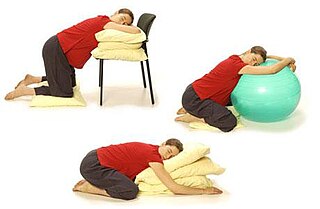 W
WBack labor is a term referring to sensations of pain or discomfort that occur in the lower back, just above the tailbone, to a mother during childbirth.
 W
WBirth tourism is the practice of traveling to another country for the purpose of giving birth in that country. The main reason for birth tourism is to obtain citizenship for the child in a country with birthright citizenship. Such a child is sometimes called an "anchor baby" if their citizenship is intended to help their parents obtain permanent residency in the country. Other reasons for birth tourism include access to public schooling, healthcare, sponsorship for the parents in the future, or even circumvention of China's two-child policy. Popular destinations include the United States and Canada. Another target for birth tourism is Hong Kong, where some mainland Chinese citizens travel to give birth to gain right of abode for their children.
 W
WBirth trauma refers to damage of the tissues and organs of a newly delivered child, often as a result of physical pressure or trauma during childbirth. The term also encompasses the long term consequences, often of cognitive nature, of damage to the brain or cranium. Medical study of birth trauma dates to the 16th century, and the morphological consequences of mishandled delivery are described in Renaissance-era medical literature. Birth injury occupies a unique area of concern and study in the medical canon. In ICD-10 "birth trauma" occupied 49 individual codes (P10-Р15).
 W
WBonzun is a Swedish-based company, with backing from both the World Health Organization and UNICEF. Bonzun helps pregnant women get access to information previously not available online. Their main focus is pregnancy information to the Chinese people.
 W
WCaesarean section, also known as C-section, or caesarean delivery, is the surgical procedure by which one or more babies are delivered through an incision in the mother's abdomen, often performed because vaginal delivery would put the baby or mother at risk. Reasons for the operation include obstructed labor, twin pregnancy, high blood pressure in the mother, breech birth, and problems with the placenta or umbilical cord. A caesarean delivery may be performed based upon the shape of the mother's pelvis or history of a previous C-section. A trial of vaginal birth after C-section may be possible. The World Health Organization recommends that caesarean section be performed only when medically necessary. Some C-sections are performed without a medical reason, upon request by someone, usually the mother.
 W
WA caudle was a hot drink that recurred in various guises throughout British cuisine from the Middle Ages into Victorian times. It was thick and sweet, and seen as particularly suitable and sustaining for invalids and new mothers. At some periods of history, caudle recipes were based on milk and eggs, like eggnog. Later variants were more similar to a gruel, a sort of drinkable oatmeal porridge. Like the original forms of posset, a caudle was usually alcoholic.
 W
WA chignon is a temporary swelling left on an infant's head after a ventouse suction cap has been used to deliver him or her. It is not a sign of serious injury and may take as little as two hours or as long as two weeks to disappear.
 W
WA painted desco da parto was an important symbolic gift on the occasion of a successful birth in late medieval and Early Modern Florence and Siena. The surviving painted deschi represented in museum collections were commissioned by elite families, but inventories show that birth trays and other special birth objects like embroidered pillows were kept long after the successful birth in families of all classes: when Lorenzo de' Medici died, the inventory shows that the desco da parto given by his father to his mother, Lucrezia Tornabuoni, at her lying-in, was hanging in his private quarters to the day of his death.
 W
WA doula is a trained companion who is not a healthcare professional and who supports another individual through a significant health-related experience, such as childbirth, miscarriage, induced abortion or stillbirth, or non-reproductive experiences such as dying. A doula may also provide support to the client's partner, family, and friends.
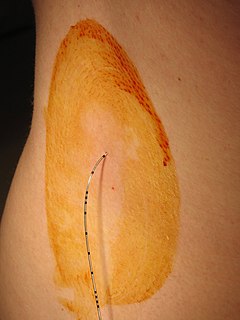 W
WEpidural administration is a method of medication administration in which a medicine is injected into the epidural space around the spinal cord. The epidural route is used by physicians and nurse anesthetists to administer local anesthetic agents, analgesics, diagnostic medicines such as radiocontrast agents, and other medicines such as glucocorticoids. Epidural administration involves the placement of a catheter into the epidural space, which may remain in place for the duration of the treatment. The technique of intentional epidural administration of medication was first described in 1921 by Spanish military surgeon Fidel Pagés. In the United States, over 50% of childbirths involve the use of epidural anesthesia.
 W
WImpurity after childbirth is the religious or cultural belief that a new mother is in a state of uncleanliness or pollution, requiring ritual purification. It is connected to the seclusion imposed by the expectations of postpartum confinement, and more broadly to the taboos around menstruation and bleeding.
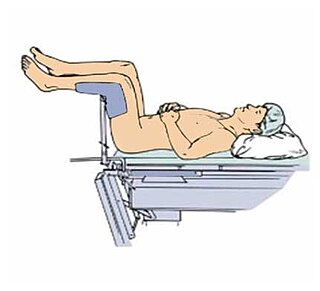 W
WThe lithotomy position is a common position for surgical procedures and medical examinations involving the pelvis and lower abdomen, as well as a common position for childbirth in Western nations. The lithotomy position involves the positioning of an individual's feet above or at the same level as the hips, with the perineum positioned at the edge of an examination table. References to the position have been found in some of the oldest known medical documents including versions of the Hippocratic oath ; the position is named after the ancient surgical procedure for removing kidney stones and bladder stones via the perineum. The position is perhaps most recognizable as the 'often used' position for childbirth: the patient is laid on the back with knees bent, positioned above the hips, and spread apart through the use of stirrups.
 W
WIn human reproduction, a live birth occurs when a fetus, whatever its gestational age, exits the maternal body and subsequently shows any sign of life, such as voluntary movement, heartbeat, or pulsation of the umbilical cord, for however brief a time and regardless of whether the umbilical cord or placenta are intact.
 W
WLotus birth is the practice of leaving the umbilical cord uncut after childbirth so that the baby is left attached to the placenta until the cord naturally separates at the umbilicus. This usually occurs within 3–10 days after birth. The practice is performed mainly for spiritual purposes, including for the perceived spiritual connection between the placenta and the newborn.
 W
WLying-in is the term given to the European forms of postpartum confinement, the traditional practice involving long bed rest before and after giving birth. The term and the practice it describes are old-fashioned or archaic, but it used to be considered an essential component of the postpartum period, even if there were no medical complications during childbirth.
 W
WThe McRoberts maneuver is an obstetrical maneuver used to assist in childbirth. It is named after William A. McRoberts, Jr. It is employed in case of shoulder dystocia during childbirth and involves hyperflexing the mother's legs tightly to her abdomen. It is effective due to the increased mobility at the sacroiliac joint during pregnancy, allowing rotation of the pelvis and facilitating the release of the fetal shoulder. If this maneuver does not succeed, an assistant applies pressure on the lower abdomen. Current guidelines strongly recommend against pulling on the infants head, as this could lead to brachial plexus injury. Instead, support while keeping the neck straight is indicated. The technique is effective in about 42% of cases. Note that suprapubic pressure and McRobert's maneuver together will resolve 90% of cases.
 W
WThe role of men in childbirth in the Western world has become more participatory than it was in the past. More Western women want their male partners to give active assistance during pregnancy and childbirth.
 W
WMidwifery is the health science and health profession that deals with pregnancy, childbirth, and the postpartum period, in addition to the sexual and reproductive health of women throughout their lives. In many countries, midwifery is a medical profession. A professional in midwifery is known as a midwife.
 W
WStories of miraculous births often include conceptions by miraculous circumstances and features such as intervention by a deity, supernatural elements, astronomical signs, hardship or, in the case of some mythologies, complex plots related to creation.
 W
WA monthly nurse is a woman who looks after a mother and her baby during the postpartum or postnatal period. The phrase is now largely obsolete, but the job continues under other names and various conditions around the world.
 W
WAntenatal perineal massage (APM) or birth canal widening (BCW) is the massage of a pregnant woman's perineum around the opening to the vagina, performed anywhere in the 4 to 6 weeks before childbirth and usually on 4-6 separate occasions. The practice aims to more gently mimic the massaging action of a baby's head on the opening to the birth canal prior to birth, which enables some of the hard work of labour to be done before the start of labour. The intention is to attempt to prevent tearing of the perineum during birth, and reduce the need for an episiotomy or an instrument delivery.
 W
WPostpartum confinement refers to a traditional practice following childbirth. Those who follow these customs typically begin immediately after the birth, and the seclusion or special treatment lasts for a culturally variable length: typically for one month or 30 days, up to 40 days, two months or 100 days. This postnatal recuperation can include care practices in regards of "traditional health beliefs, taboos, rituals, and proscriptions." The practice used to be known as "lying-in", which, as the term suggests, centres around bed rest. In some cultures it may be connected to taboos concerning impurity after childbirth.
 W
WThe postpartum period begins immediately after childbirth as the mother's body, including hormone levels and uterus size, returns to a non-pregnant state. The terms puerperium, puerperal period, or immediate postpartum period are commonly used to refer to the first six weeks following childbirth. The World Health Organization (WHO) describes the postnatal period as the most critical and yet the most neglected phase in the lives of mothers and babies; most maternal and newborn deaths occur during this period. In scientific literature, the term is commonly abbreviated to Px, where x is a number; for example, "day P5" should be read as "the fifth day after birth". This is not to be confused with the medical nomenclature that uses G P to stand for number and outcomes of pregnancy.
 W
WPrenatal care, also known as antenatal care, is a type of preventive healthcare. It is provided in the form of medical checkups, consisting of recommendations on managing a healthy lifestyle and the provision of medical information such as maternal physiological changes in pregnancy, biological changes, and prenatal nutrition including prenatal vitamins, which prevents potential health problems throughout the course of the pregnancy and promotes the mother and child's health alike.The availability of routine prenatal care, including prenatal screening and diagnosis, has played a part in reducing the frequency of maternal death, miscarriages, birth defects, low birth weight, neonatal infections and other preventable health problems.
 W
WProlonged labor is the inability of a woman to proceed with childbirth upon going into labor. Prolonged labor typically lasts over 20 hours for first time mothers, and over 14 hours for women that have already had children. Failure to progress can take place during two different phases; the latent phase and active phase of labor. The latent phase of labor can be emotionally tiring and cause fatigue, but it typically does not result in further problems. The active phase of labor, on the other hand, if prolonged, can result in long term complications.
 W
WIn placental mammals, the umbilical cord is a conduit between the developing embryo or fetus and the placenta. During prenatal development, the umbilical cord is physiologically and genetically part of the fetus and normally contains two arteries and one vein, buried within Wharton's jelly. The umbilical vein supplies the fetus with oxygenated, nutrient-rich blood from the placenta. Conversely, the fetal heart pumps low oxygen, nutrient-depleted blood through the umbilical arteries back to the placenta.
 W
WUnassisted childbirth (UC) refers to the process of intentionally giving birth without the assistance of a medical birth attendant. It may also be known as freebirth, DIY (do-it-yourself) birth, unhindered birth, and unassisted home birth. Unassisted childbirth is by definition a planned process, and is thus distinct from unassisted birth due to reasons of emergency, lack of access to a skilled birth attendant, or other. It is also different from homebirth, although most UCs also happen within the home.
 W
WVacuum extraction (VE), also known as ventouse, is a method to assist delivery of a baby using a vacuum device. It is used in the second stage of labor if it has not progressed adequately. It may be an alternative to a forceps delivery and caesarean section. It cannot be used when the baby is in the breech position or for premature births. The use of VE is generally safe, but it can occasionally have negative effects on either the mother or the child. The term comes from the French word for "suction cup".
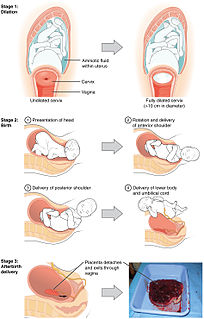 W
WA vaginal delivery is the birth of offspring in mammals through the vagina. It is the most common method of childbirth worldwide. It is considered the preferred method of delivery, with lower morbidity and mortality than Caesarean sections (C-sections).
 W
WWater birth is labor and sometimes delivery that occurs in water, usually a birthing pool. The American College of Obstetricians and Gynecologists does not recommend birthing in water as the safety has not been determined. Proponents believe childbirth in water results in a more relaxed, less painful experience that promotes a midwife-led model of care. Critics argue that the safety of waterbirth has not been scientifically proven and that a wide range of adverse neonatal outcomes have been documented, including increased mother or child infections and the possibility of infant drowning. A 2018 Cochrane Review of water immersion in the first stages of labor found evidence of fewer epidurals and few adverse effects but insufficient information regarding giving birth in water.